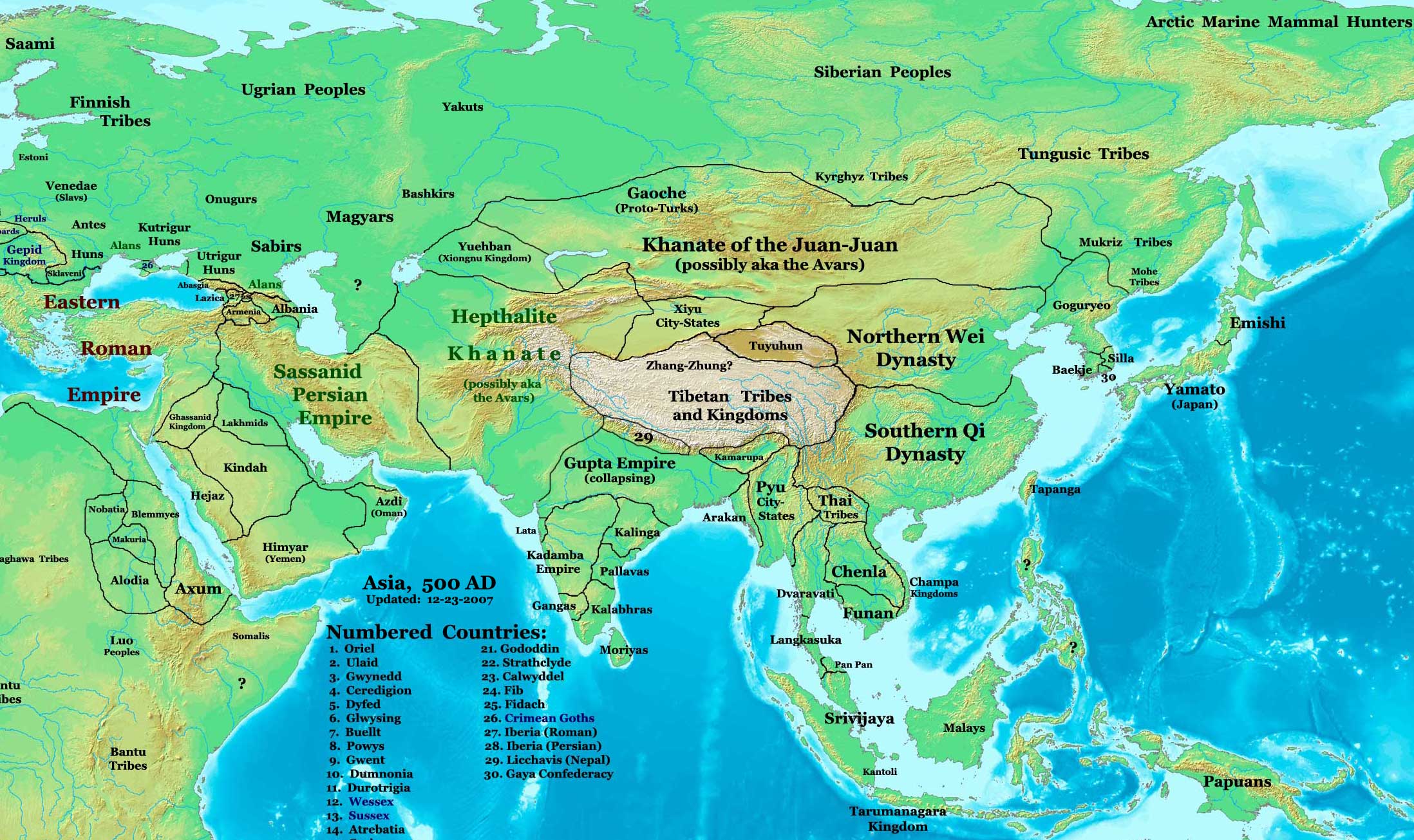- Rouran
Infobox Former Country
native_name =
conventional_long_name = Rouran
Juan-Juan Empire
common_name = Rouran
continent = Asia
region =
country =
era = Early Middle Ages
status =
status_text =
empire =
government_type = Monarchy
year_start = 4th Century
year_end = 555
event_start =
date_start =
event_end =
date_end =
event1 =
date_event1 =
event_pre =
date_pre =
event_post =
date_post =
p1 = Xianbei
flag_p1 =
s1 = Göktürk Empire
flag_s1 =
s2 = Northern Qi
flag_s2 =
s3 = Northern Zhou
flag_s3 =
flag_type =
symbol =
symbol_type =
image_map_caption = Asia in 500AD, showing the Juan-Juan Empire and its neighbors.
capital =
national_motto =
national_anthem =
common_languages =
religion =Tengrism
currency =
legislature =Kurultai
leader1 =Yùjiǔlǘ Mùgǔlǘ
leader2 =Yujiulü Dengshuzi
year_leader1 = 4th Century
year_leader2 = 555
title_leader = KhaganRouran (Zh-cpl|c=柔然|p=Róurán|l=soft-like;
Wade-Giles : Jou-jan), Ruanruan/Ruru (Zh-cpl|c=蠕蠕/茹茹 |p=Ruǎnruǎn/Rúrú|l=wriggling insects/fodder) also known as Tan Tan [Zhang, Min. [http://www.cqvip.com/content/citation.dll?id=8987013&SUID=C33BCF1F274EE593D4E995649AA1DA91 "Lun Beiwei Changcheng Junzheng Fangwei Tixi De Jianli" ("On the Defensive System of Great Wall Military Town of Northern Wei Dynasty")] China’s Borderland History and Geography Studies, Jun. 2003 Vol. 13 No. 2. Page 15.] (Zh-cpl|c=檀檀|p=Tántán|l=Tartar ) was the name of a confederation ofnomad ic tribes on the northern borders ofChina Proper from the late4th century until the late6th century . It has sometimes been hypothesized that the Rouran are identical to theEurasian Avars who later appeared in Europe. The term Rouran is a Mandarin Chinese transcription of the pronunciation of the name the confederacy used to refer to itself. Ruanruan and Ruru remained in modern usage despite once being derogatory. They derived from orders given by the Emperor Taiwu ofNorthern Wei , who waged war against the Rouran and intended to intimidate the confederacy.The power of the Rouran was broken by an alliance ofGöktürks , the ChineseNorthern Qi andNorthern Zhou dynasties and tribes in Central Asia in552 .Origin and expansion
The Rouran were confederation of Xianbei people who remained in Mongolian steppes after most Xianbei migrated south to Northern China and set up various kingdoms. They were first noted as having defeated the Gaoche and establishing an empire extending all the way to the
Hulun , at the easternInner Mongolia . To the west of the Rouran was a horde known in the west as theHephthalites who originally, until the5th century , were a vassal horde of the RouranFact|date=February 2007. The Rouran controlled the area ofMongolia from the Manchurian border toTurpan and, perhaps, the east coast ofLake Balkhash , and from theOrkhon River to theChina Proper . Their ancestor Mugulu is said to have been originally a slave of the Toba tribes, situated at the north banks of Yellow River Bend. Mugulu's descendant Shelun is said to be the first chieftain who was able to unify the Rouran tribes and to found the power of the Rouran by defeating the Gaoche andXianbei . Shelun was also the first of the steppe peoples to adopt the title ofkhagan (可汗) in402 , originally a title of Xianbei nobility.The Rouran and the Hephthalites had a falling out and problems within their confederation were encouraged by Chinese agents. In
508 , the Gaoche, then operating under the name Tiele, defeated the Rouran in battle. In516 , the Rouran defeated the Tiele. Within the Rouran confederation was a Turkic tribe noted in Chinese annals as the Tujue. After a marriage proposal to the Rouran was rebuffed, the Tujue joined with the Western Wei, successor state to the Northern Wei, and revolted against the Rouran. In555 , they beheaded 3,000 Rouran. European history books commonly claim that the Rouran then fled west across the steppes and became the Avars, though this is probably a mistake. The remainder of the Rouran fled into China, were absorbed into the border guards, and disappeared forever as an entity. The last Rouran khagan fled to the court of Western Wei, but at the demand of Tujue, Western Wei executed him and the nobles that accompanied him.Little is known of the Rouran ruling elite, which the "
Book of Wei " cited as an offshoot of the Xianbei. The Rouran subdued modern regions ofXinjiang , Mongolia,Central Asia and parts ofSiberia and Manchuria from the late4th century . Their frequent interventions and invasions profoundly affected neighboring countries. Though they admitted theAshina ofGöktürks into their federation, the power of the Rouran was broken by an alliance of Göktürks, the Chinese Northern Qi and Northern Zhou dynasties and tribes in Central Asia in552 . The Northern Wei, for instance, established the Six Garrisons bordering the Rouran, which later became the foci of several major mutinies in the early6th century .
=Qaghans of the Rouran=ources
* [http://www.shuku.net:8080/novels/zatan/cydglngls/03.html Map of their empire]
* [http://www.human.toyogakuen-u.ac.jp/~acmuller/dicts/dealt/data/88/c8815.htm Definition]
* [http://www.chinaknowledge.de/History/Altera/rouran.html information about the Rouran]
* Kradin, Nikolay. "From Tribal Confederation to Empire: the Evolution of the Rouran Society". Acta Orientalia Academiae Scientiarum Hungaricae, Vol. 58, No 2 (2005): 149-169.ee also
*
Battle of Ikh Bayan
Wikimedia Foundation. 2010.
